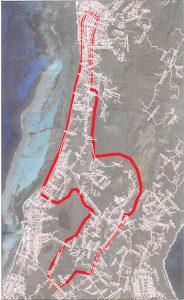Residents told not to drink tap water from 12 areas on Saipan
The Commonwealth Utilities Corp. has detected levels of perfluorooctane sulfonate (PFOS) and perfluorooctanoic acid (PFOA) that exceed the U.S. Environmental Protection Agency Health Advisory level of 70 parts per trillion (ppt) in a limited area of its drinking water system. The affected area includes the villages of Chalan Laulau, Iliying, Chalan Kiya, As Terlaje, Kannat Tabla, Fina Sisu, San Jose, and parts of southern Garapan, Gualo Rai, Susupe, As Lito, and As Perdido.
CUC is advising consumers in these areas to avoid ingesting the water at this time and until the concentrations of PFOS and PFOA are below the health advisory level. Consumers should not drink tap water, cook with tap water, or make ice for consumption with tap water. CUC is making this advisory action to help the affected population limit their lifetime exposure to these chemicals.
History
On May 19, 2016, EPA issued new nationwide drinking water health advisories regarding two chemical contaminants: perfluorooctane sulfonate (PFOS) and perfluorooctanoic acid (PFOA). These health advisories are based on the latest science available and help local water systems and regulatory agencies take appropriate steps to address PFOA and PFOS if needed.
PFOS and PFOA are human-made substances and are not naturally found in the environment. They have been used extensively in commercial goods (carpets, clothing, furniture, paper packaging for food) and in materials that are resistant to water, grease, or stains such as cookware. They are also used in firefighting foams at airfields and in a number of industrial processes. Between 2000 and 2002, PFOS was voluntarily phased out of production in the U.S. by its primary manufacturer.
While consumer products are a large source of human exposure to these chemicals, drinking water can be an additional source of exposure in communities where these chemicals have entered and contaminated water supplies. Such contamination is typically localized and associated with a specific facility, for example, an airfield at which they were used for firefighting.
EPA has established lifetime health advisories of 70 parts per trillion for combined concentrations of PFOA and PFOS in drinking water. EPA health advisories include a margin of protection from adverse health effects when consumed at these levels over a lifetime.

Area inside red line received water that exceeded the Health Advisory Level of 70 ppt for PFOS and PFOA as of April 30, 2019. (Contributed Photo)
Studies indicate that exposure to PFOA and PFOS over certain levels may result in adverse health effects, including developmental effects to fetuses during pregnancy or to breastfed infants (e.g., low birth weight, accelerated puberty, skeletal variations), cancer (e.g., testicular, kidney), liver effects (e.g., tissue damage), immune effects (e.g., antibody production and immunity), thyroid effects, and other effects (e.g., cholesterol changes).
What CUC has done?
In compliance with EPA and CNMI Bureau of Environmental and Coastal Quality (BECQ) requirements, CUC conducted unregulated contaminant monitoring of its drinking water supplies in 2015 and 2016. In May 2016, EPA and BECQ requested that CUC conduct follow-up monitoring of its supplies for PFOA and PFOS. CUC conducted additional testing in June 201 and continues to conduct additional monitoring. The results of this monitoring resulted in CUC removing eight wells in the Isley and Obyan well fields near the Saipan International Airport from service.
Updated information
On April 30, 2019, CUC collected a sample from the As Terlaje Tank to monitor the concentration levels of PFOS and PFOA in the water supply. The As Terlaje Tank receives water from the suspected source of the initial contamination. Results received by CUC on May 20, 2019 indicated the concentration of PFOS and PFOA was 72.6 parts per trillion (ppt), exceeding the health advisory of 70 parts per trillion (ppt). The As Terlaje Tank provides water to the following areas: Chalan Laulau, lliying, Chalan Kiya, As Terlaje, Kannat Tabla, Fina Sisu, San Jose, and parts of southern Garapan, Gualo Rai, Susupe, As Lito, and As Perdido.
What CUC is doing about the problem?
It is not possible to take all wells containing PFOS and PFOA out of service without dramatically affecting delivery of water to customers. The goal is to reduce the combined concentration from all wells to below the health advisory level. To achieve this goal, CUC is taking the following measures:
1. CUC has removed from service eight (8) wells with elevated levels of PFOS and PFOA.
2. CUC will continue to test the concentration of PFOS and PFOA in all the wells presently supplying water to the areas affected by this advisory.
3. CUC will also continue to monitor for these contaminants at the sources surrounding the affected areas.
4. CUC will report to BECQ and the community the results of all further testing.
5. CUC is presently pursuing funding to purchase and install granular activated carbon (GAC) filtration systems, which have proven to remove these specific contaminants.
For more information about PFOA and PFOS visit EPA’s webpage https://www.epa.gov/gr0tmd•water-and-drinking-water/clrinking-water-health-advisories-pfoa-and-pfos or contact the BECQ Safe Drinking Water Program at (670) 664-8500. (PR)























